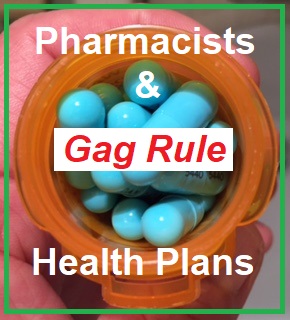
Purchasing prescription medication outside of a consumer’s health plan is good for the insurance company and bad for the consumer.
President Trump signed legislation on October 9, 2018, lifting any gag rules on pharmacists from discussing lower priced prescription medications with consumers. The result will be good for health insurance companies and bad for health plan members. Instead of creating more drug price transparency, health plan members will actually undercut the benefits of their health insurance.
Gag Rule Prevented Drug Cost Comparison
The gag rule built into many pharmacy contracts prevented the pharmacist from discussing potentially lower priced medications with consumers. Specifically, the gag rule prevented the discussion of drug options if the consumer were to pay out-of-pocket and not use their health insurance to purchase the drug. While many pharmacists are very knowledgeable, deciding on a drug purely based on cost is not always the best idea.
Why Did The Doctor Prescribe The Drug?
First, there may be good reasons why the consumer’s doctor prescribed the medication. Perhaps the patient can only tolerate a certain formula of the medication only made by a pharmaceutical company that has a higher price. The pharmacist does not know the consumer’s medical history and should not be pushing lower cost drugs, which they may make a higher profit on, in place of the prescribed medication.
Health Insurance Lowers Drug Prices
Second, not purchasing the prescription medication through the health plan of the consumer diminishes the value of the health insurance that the consumer is paying for. Many health plans have a pharmacy deductible that must be met before the health plan member transitions into set copayments for prescription medication. For example, the Covered California standard benefit design Silver 70 plan has $200 pharmacy deductible for 2019. Once the plan member has met the pharmacy deductible, a 30 day supply of drugs drops: generic drugs become $15, Tier 2 at $55, Tier 3 at $80, and Tier 4 specialty drugs at 20% coinsurance not to exceed $250 per script.
Before the deductible met, the consumer must pay the full over the counter cost for the drug. (The real issue here is that pharmacies won’t divulge the price of drugs on their website for comparison shopping). If the consumer never runs their drug purchases through the health plan, they can never get the lower priced copayments. A drug may cost $100 per month before the deductible is met and then drop to $55 after the deductible. If the pharmacist sells the consumer a similar drug for $80, and the purchase doesn’t go through the health insurance, the consumer will never get the $55 copayment of the Silver 70 health plan.
In addition, all prescription drug costs go toward meeting the maximum out-of-pocket amount. All the costs of health care services, labs, test, surgeries, imaging, and drug cost through the health plan accumulate toward meeting the maximum out-of-pocket amount. Once the maximum out-of-pocket amount is met, all of the covered services and prescription medications are paid 100% by the health plan.
Not Using Health Plan Is Good For Health Insurance Companies
By paying for prescription drugs out-of-pocket, and not having them accumulate toward the maximum out-of-pocket amount for the health plan member helps the insurance company, not the consumer. Not having the drug costs go through the health plan could cost the consumer thousands of extra dollars in health care expenses because they did not meet their maximum out-of-pocket amount for the year.
Lifting the gag rule on pharmacists sounds like a good idea, but unless it is paired with a discussion not only of the cost of the drug, but also the implications for the consumer’s health insurance benefits, it’s bad for the consumer. Pharmacists are not going to understand everyone’s health insurance plan and how it operates. There may be instances when paying for a lower over-the-counter cost for a drug makes sense for the consumer. But who is going to make sure that the purchase, which isn’t run through the health plan, is in the consumer’s best interest? It won’t be the pharmacist.